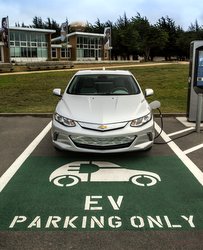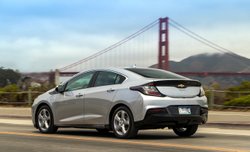The Perfect Green Car for Today?

The all-new 2016 Chevrolet Volt may be the best solution today for moving to greener driving to reduce CO2 emissions and mitigate the effects of climate change. It’s an electric vehicle (EV) without the drawbacks.
The many advantages of driving an EV include smooth, quiet motoring, minimal service requirements, and the feeling that you’re part of the solution, not the problem.
The downsides of EVs include limited range and the long time it takes to recharge the batteries.
Regular hybrid vehicles combine gas engines with electric motors to extend your fuel out over more miles, but you never plug in. Plug-in hybrids provide a small all-electric range before becoming regular hybrids.
The Volt Path
The Chevrolet Volt, which debuted for 2011, was designed as an electric car with a range extender—The Voltec electric drive system. You could charge it up, drive about 35 miles, and then its small gasoline engine kicked in to generate electricity to keep the motor moving the car along.

The totally redesigned 2016 Volt continues on this path, with huge upgrades. Generation one owners gave GM plenty of feedback. Gone are the hard plastic panels with haptic touch controls. The styling is in line with current Chevy gasoline vehicles, like the midsize Malibu. The new car looks great inside and out, with colors and metallic trim befitting a fancier vehicle.
What’s most important, though, is that the new Volt offers an electric range of 53 miles. In a week with my Mosaic Black Metallic test car, I drove in silent, serene full-electric mode for all of my commuting (18 miles each way to work and home), and all of my normal errands. On only two occasions did I need the extended gasoline range. The combined range for gas and electric is 420 miles.
When my Volt switched over to gasoline, the instrument panel indicated I had moved from battery power. I could hardly hear the engine when it engaged; even when the battery was depleted, the car sometimes used it with power generated from braking.
MPG & MPGe
An electric car is rated for MPGe. MPGe assigns a comparative value to the efficiency of different EVs, but it also stands alongside MPG. My week with the Volt generated 118.1 MPGe. The EPA’s ratings are 106 MPGe for electric mode and 42 MPG for gasoline (combined city/highway numbers). Green scores are 8 for Smog and a perfect 10 for Greenhouse Gas.
Compare that to a standard Prius, which gets 52 combined MPG. The Chevrolet Cruze, the Volt’s gasoline cousin, earns 35 MPG combined, itself a laudable number.

The electric motor puts out 149 horsepower (111 kW) and a strong 294 lb.-ft. of torque. The gas engine generates only 75 horsepower, but it’s meant to charge the car’s batteries rather than drive it. Chevy claims an 8.4-second 0-60 time. I felt confident in it driving uphill on a winding road in the rain.
The 2016 Chevrolet Volt comes in LT and Premier levels. My Premier tester flaunted an attractive two-tone interior with tan inserts and silvery trim winding around the dash. The center screen is nicely rendered and there’s a jaunty blue plastic top on the “shift” knob. The rear seat now offers a center position, but there’s not a whole lot of legroom for that person. The hatchback is convenient, although it’s a high liftover.
Drive Modes
The Drive Mode switch lets you configure the Voltec system. Use “Normal” mode for maximum efficiency, “Sport” mode to take advantage of the bountiful electric motor torque, or “Mountain” mode for maximum power on steep upgrades. The fourth mode, “Hold,” lets you preserve your battery charge and use only gasoline.
Regenerative braking is crucial for hybrids and EVs, but the Volt lets you prime the pump with a paddle on the left side of the steering wheel for “Regen on Demand.” Use it like a brake, while

banking charge. With practice, you can drive almost without using the brake pedal at all.
The Volt has its own personality, with a greeting sound and a “wind down” tone it makes when you turn it off. Because the electric motor is silent when you start the car, the blue Power button is more like turning on your iPhone than turning over your engine.
The LT starts at $34,820 and the Premier, with heated leather seats, a Bose stereo system and more, starts at $39,270. My tester listed for $39,850. Various leasing options, plus some Federal and State rebates, can make these cars easier to drive home.
While an all-electric car may be the ideal way to go, it’s not practical for everyone today. But if you want a compact car that’ll do pretty much everything and lets you drive electric most of the time, the 2016 Chevrolet Volt is a great solution.
Related Stories You Might Enjoy:
Road Test: 2017 Chevrolet Volt
News: 2016 Chevy Volt Wins Green Car of the Year
Feature: Chevy Volt Replaces Nissan Leaf
Feature: Early Owners Love Their Chevy Volts
Disclosure:
Clean Fleet Report is loaned free test vehicles from automakers to evaluate, typically for a week at a time. Our road tests are based on this one-week drive of a new vehicle. Because of this we don’t address issues such as long-term reliability or total cost of ownership. In addition we are often invited to manufacturer events highlighting new vehicles or technology. As part of these events we may be offered free transportation, lodging or meals. We do our best to present our unvarnished evaluations of vehicles and news irrespective of these inducements.
Our focus is on vehicles that offer the best fuel economy in their class. We also feature those that are among the top mpg vehicles in their class. In addition, we aim to offer reviews and news on advanced technology and the alternative fuel vehicle market. We welcome any feedback from vehicle owners and are dedicated to providing a forum for alternative viewpoints. Please let us know your views at publisher@cleanfleetreport.com.

8 thoughts on “Road Test: 2016 Chevrolet Volt”